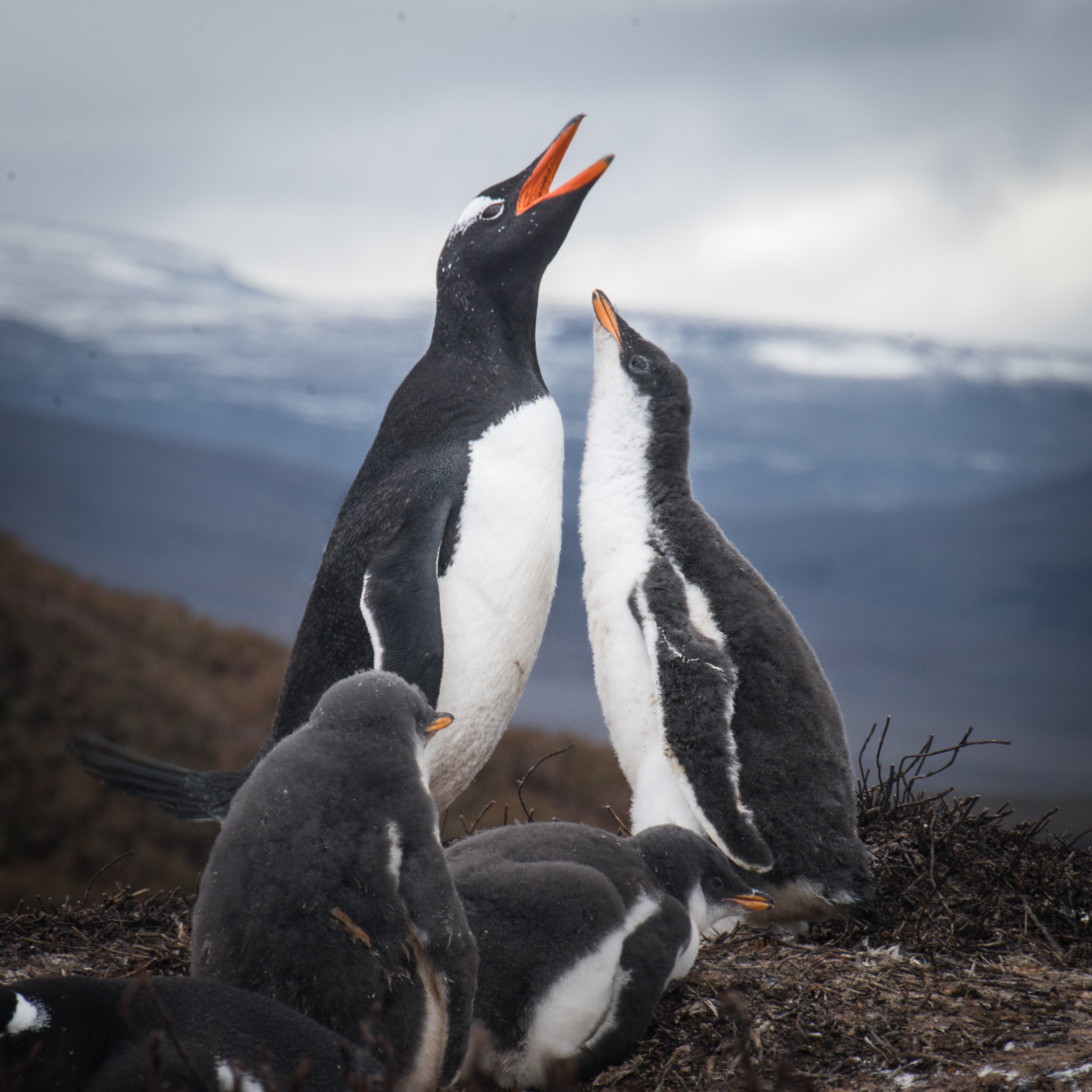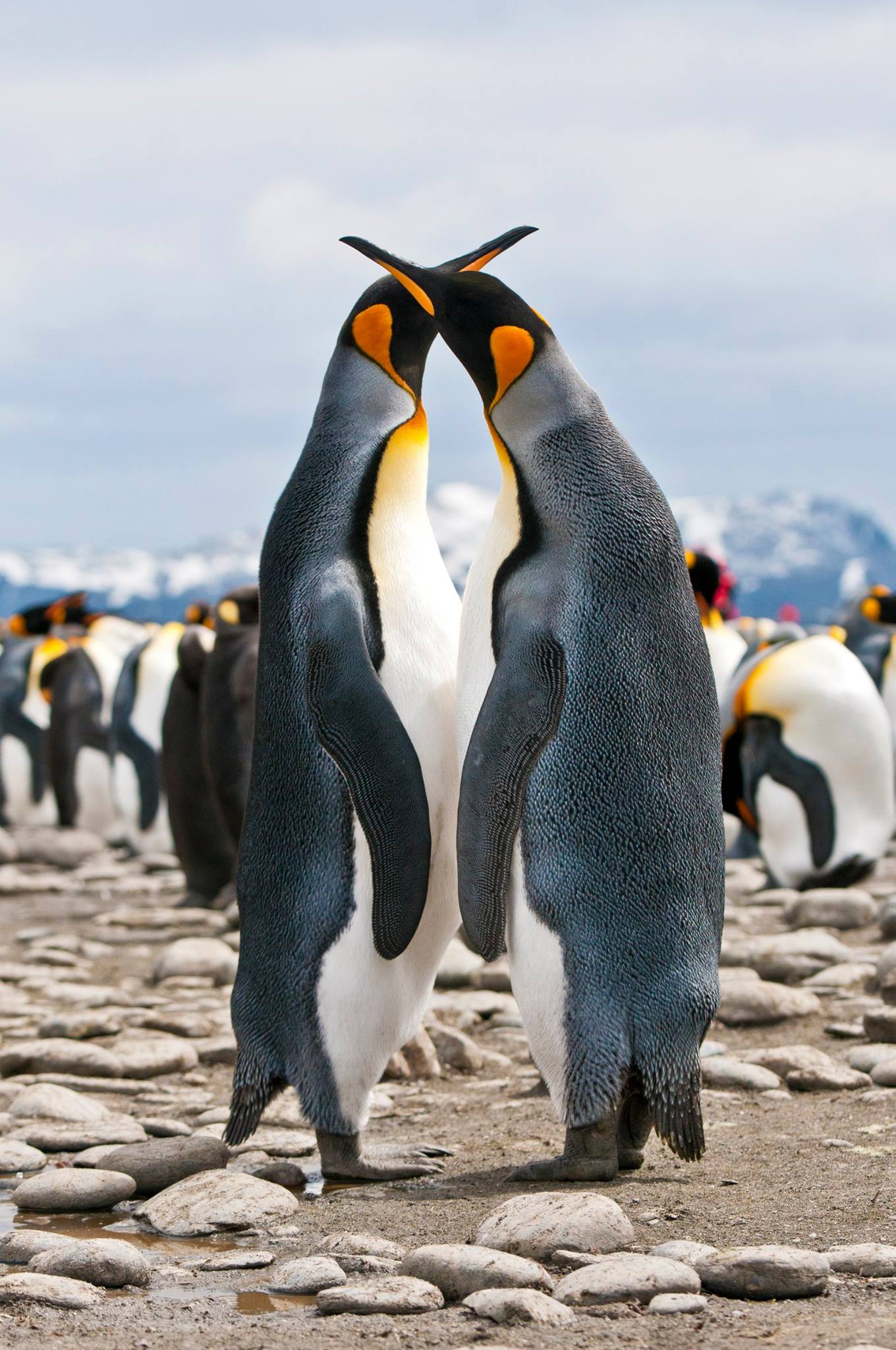|
Gentoo Penguin
The gentoo penguin ( ) (''Pygoscelis papua'') is a penguin species (or possibly a species complex) in the genus ''Pygoscelis'', most closely related to the Adélie penguin (''P. adeliae'') and the chinstrap penguin (''P. antarcticus''). The earliest scientific description was made in 1781 by Johann Reinhold Forster with a type locality in the Falkland Islands. The species calls in a variety of ways, but the most frequently heard is a loud trumpeting, which the bird emits with its head thrown back. Names The application of "gentoo" to the penguin is unclear. '' Gentoo'' was an Anglo-Indian term to distinguish Hindus from Muslims. The English term may have originated from the Portuguese ''gentio'' ("pagan, gentile"). Some speculate that the white patch on the bird's head was thought to resemble a turban. It may also be a variation of another name for this bird, "Johnny penguin", with Johnny being the Spanish counterpart of and sounding vaguely like gentoo. The Johnny rook, a pr ... [...More Info...] [...Related Items...] OR: [Wikipedia] [Google] [Baidu] |
Brown Bluff
Brown Bluff is a basalt tuya on the Tabarin Peninsula of northern Antarctica. It formed in the last 1 million years as a result of subglacial eruptions within an englacial lake. The volcano's original diameter is thought to have been about and was probably formed by a single vent. Brown Bluff is divided into four stages: pillow lava, pillow volcano, tuff cone, slope failure, and hyaloclastite delta; and into five structural units. The volcano gets its name from its steep slopes and brown-to-black hyaloclastite. It was applied by the Falkland Islands Dependencies Survey following their survey in 1946. Environment Topography Brown Bluff has a cobble and volcanic ash, ash beach rising increasingly steeply towards towering red-brown tuff cliffs embedded with volcanic bomb, bombs and tephra. The cliffs are heavily eroded, resulting in loose scree and rock falls on higher slopes, and large, wind-eroded boulders on the beach. Permanent ice and tidewater glaciers surround the sit ... [...More Info...] [...Related Items...] OR: [Wikipedia] [Google] [Baidu] |
Specific Name (zoology)
In zoological nomenclature, the specific name (also specific epithet, species epithet, or epitheton) is the second part (the second name) within the scientific name of a species (a binomen). The first part of the name of a species is the name of the genus or the generic name. The rules and regulations governing the giving of a new species name are explained in the article species description. For example, the scientific name for humans is ''Homo sapiens'', which is the species name, consisting of two names: ''Homo'' is the " generic name" (the name of the genus) and ''sapiens'' is the "specific name". Etymology Historically, ''specific name'' referred to the combination of what are now called the generic and specific names. Carl Linnaeus, who formalized binomial nomenclature, made explicit distinctions between specific, generic, and trivial names. The generic name was that of the genus, the first in the binomial, the trivial name was the second name in the binomial, and the ... [...More Info...] [...Related Items...] OR: [Wikipedia] [Google] [Baidu] |
Titian Peale
Titian Ramsay Peale (November 17, 1799 – March 13, 1885) was an American artist, naturalist, and explorer from Philadelphia, Pennsylvania. He was a scientific illustrator whose paintings and drawings of wildlife are known for their beauty and accuracy. Peale was a member of several high-profile scientific expeditions. In 1819–20, he and Thomas Say accompanied Stephen Harriman Long on an expedition to the Rocky Mountains. He was also a member of the United States Exploring Expedition (1838–1842). Starting around 1855, Peale became an enthusiastic amateur photographer. Many of his photographs featured buildings and landscapes in and around Washington D.C. He joined a local club with other amateur photographers and participated in field trips, photo exchanges and contests. By the end of the Civil War, his interest in photography waned and he only occasionally took pictures. Biography Family and early life Peale was born on November 17, 1799 in Philosophical Hall, P ... [...More Info...] [...Related Items...] OR: [Wikipedia] [Google] [Baidu] |
International Ornithologists' Union
The International Ornithologists' Union (IOU) is an international organization for the promotion of ornithology Ornithology, from Ancient Greek ὄρνις (''órnis''), meaning "bird", and -logy from λόγος (''lógos''), meaning "study", is a branch of zoology dedicated to the study of birds. Several aspects of ornithology differ from related discip .... It links basic and applied research and nurtures education and outreach activities. Specifically, the IOU organizes and funds global congresses on ornithology at regular intervals, sets up and supports commissions and committees on various aspects of avian biology and conservation, and initiates and backs other international ornithological activities with specific aims consistent with its own mission and goal. It discloses the names and professional affiliations of its members on its website to encourage international collaboration and networking. The IOU acts as the Ornithology Section of the International Union of Biologi ... [...More Info...] [...Related Items...] OR: [Wikipedia] [Google] [Baidu] |
Subspecies
In Taxonomy (biology), biological classification, subspecies (: subspecies) is a rank below species, used for populations that live in different areas and vary in size, shape, or other physical characteristics (Morphology (biology), morphology), but that can successfully interbreed. Not all species have subspecies, but for those that do there must be at least two. Subspecies is abbreviated as subsp. or ssp. and the singular and plural forms are the same ("the subspecies is" or "the subspecies are"). In zoology, under the International Code of Zoological Nomenclature, the subspecies is the only taxonomic rank below that of species that can receive a name. In botany and mycology, under the International Code of Nomenclature for algae, fungi, and plants, other infraspecific name, infraspecific ranks, such as variety (botany), variety, may be named. In bacteriology and virology, under standard International Code of Nomenclature of Prokaryotes, bacterial nomenclature and virus clas ... [...More Info...] [...Related Items...] OR: [Wikipedia] [Google] [Baidu] |
Aptenodytes
The genus ''Aptenodytes'' contains two extant species of penguins collectively known as "the great penguins". Etymology The name "Aptenodytes" is a composite of Ancient Greek elements, "ἀ-πτηνο-δύτης" (without-wings-diver). Taxonomy * King penguin, ''Aptenodytes patagonicus'' **''Aptenodytes patagonicus patagonicus'' **''Aptenodytes patagonicus halli'' * Emperor penguin, ''Aptenodytes forsteri'' * Ridgen's penguin (''Aptenodytes ridgeni''), an extinct species known from fossil bones of Early or Late Pliocene The Pliocene ( ; also Pleiocene) is the epoch (geology), epoch in the geologic time scale that extends from 5.33 to 2.58molecular data have shown the genus ''Aptenodytes'' to be basal ... [...More Info...] [...Related Items...] OR: [Wikipedia] [Google] [Baidu] |
Cell Nucleus
The cell nucleus (; : nuclei) is a membrane-bound organelle found in eukaryote, eukaryotic cell (biology), cells. Eukaryotic cells usually have a single nucleus, but a few cell types, such as mammalian red blood cells, have #Anucleated_cells, no nuclei, and a few others including osteoclasts have Multinucleate, many. The main structures making up the nucleus are the nuclear envelope, a double membrane that encloses the entire organelle and isolates its contents from the cellular cytoplasm; and the nuclear matrix, a network within the nucleus that adds mechanical support. The cell nucleus contains nearly all of the cell's genome. Nuclear DNA is often organized into multiple chromosomes – long strands of DNA dotted with various proteins, such as histones, that protect and organize the DNA. The genes within these chromosomes are Nuclear organization, structured in such a way to promote cell function. The nucleus maintains the integrity of genes and controls the activities of the ... [...More Info...] [...Related Items...] OR: [Wikipedia] [Google] [Baidu] |
Mitochondria
A mitochondrion () is an organelle found in the cells of most eukaryotes, such as animals, plants and fungi. Mitochondria have a double membrane structure and use aerobic respiration to generate adenosine triphosphate (ATP), which is used throughout the cell as a source of chemical energy. They were discovered by Albert von Kölliker in 1857 in the voluntary muscles of insects. The term ''mitochondrion'', meaning a thread-like granule, was coined by Carl Benda in 1898. The mitochondrion is popularly nicknamed the "powerhouse of the cell", a phrase popularized by Philip Siekevitz in a 1957 ''Scientific American'' article of the same name. Some cells in some multicellular organisms lack mitochondria (for example, mature mammalian red blood cells). The multicellular animal '' Henneguya salminicola'' is known to have retained mitochondrion-related organelles despite a complete loss of their mitochondrial genome. A large number of unicellular organisms, such as microspo ... [...More Info...] [...Related Items...] OR: [Wikipedia] [Google] [Baidu] |
King Penguin
The king penguin (''Aptenodytes patagonicus'') is the second largest species of penguin, smaller than but somewhat similar in appearance to the emperor penguin. King penguins mainly eat lanternfish, squid, and krill. On foraging trips, king penguins repeatedly dive to over , and have been recorded at depths greater than . Predators of the king penguin include giant petrels, skuas, the snowy sheathbill, the leopard seal, and the orca. The king penguin breeds on the subantarctic islands at the northern reaches of Antarctica, South Georgia Island, South Georgia, southern Argentina, and other temperate islands of the region. It also lives on Macquarie Island in the Southern Ocean and the Falkland Islands. This bird was exploited commercially in the past for its blubber, oil, meat, and feathers. Today it is fully protected. Taxonomy In 1778, the English illustrator John Frederick Miller included a hand-coloured engraving of the king penguin in his ''Icones animalium et plantarum''. ... [...More Info...] [...Related Items...] OR: [Wikipedia] [Google] [Baidu] |
Pierre Sonnerat
Pierre Sonnerat (18 August 1748 – 31 March 1814) was a French naturalist, colonial administrator, writer and explorer. He described numerous species of plants and animals on his travels and is honoured in the genus ''Sonneratia'' and in other specific names such as that of the grey junglefowl ''Gallus sonneratii.'' Life and travels Sonnerat was born in Lyon and was the nephew of the botanist Pierre Poivre (mother of Pierre Sonnerat, Benoîte Poivre, was a cousine of Pierre Poivre) who was a French colonial administrator in the Mascarenes. Sonnerat became a private secretary to his uncle Pierre and made several voyages to southeast Asia, visiting the Philippines and Moluccas between 1769 and 1772. In Mauritius, Sonnerat met the naturalist Philibert Commerson in 1767 and worked for him briefly, travelling to Reunion. He then worked as a naval commissar and travelled to India and China from 1774 to 1781 with a base in Yanam and Pondicherry. From 1781 to 1785, he was in Fran ... [...More Info...] [...Related Items...] OR: [Wikipedia] [Google] [Baidu] |
Macquarie Island
Macquarie Island is a subantarctic island in the south-western Pacific Ocean, about halfway between New Zealand and Antarctica. It has been governed as a part of Tasmania, Australia, since 1880. It became a Protected areas of Tasmania, Tasmanian State Reserve in 1978 and was inscribed as a UNESCO World Heritage Site in 1997. Macquarie Island is an exposed portion of the Macquarie Fault Zone, Macquarie Ridge and is located where the Australian Plate meets the Pacific Plate. The island is home to the entire royal penguin population during their annual nesting season. Ecologically, the island is part of the Antipodes Subantarctic Islands tundra ecoregion. History 19th century Frederick Hasselborough, an Australian, discovered the uninhabited island on 11 July 1810, while looking for new seal hunting, sealing grounds. He claimed Macquarie Island for United Kingdom, Britain and annexation, annexed it to the colony of New South Wales in 1810. The island was named for Colonel Lachla ... [...More Info...] [...Related Items...] OR: [Wikipedia] [Google] [Baidu] |





